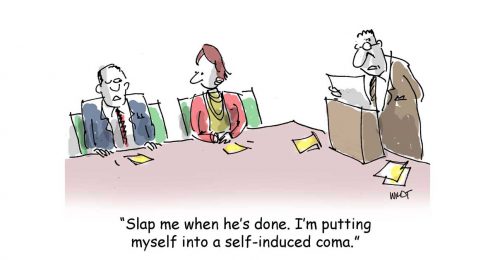I enjoyed an email from a client last week. This CEO had received an email from his board chair who had read my recent blog post, 22 Signs Your Board Meetings Suck, and decided to assess their organization’s last board meeting. The subject line read simply:
“Hey! Our board meeting hardly sucked at all!”
Turns out that my client’s organization understands the value of a great board meeting. How wonderful is that! And how sadly infrequent.
Far too often, a board meeting is big fat missed opportunity to inform, enrich and engage board members in order to ignite them to be the best ambassadors they can be.
Here’s part of another email I got. “Hey Joan, OK so my last board meeting sucked. Can your next post offer a prescription for how to make sure our next board meeting will suck less?”
Well my friends and readers, I accept that challenge. And I have good news. There is only ONE thing you need to do differently.
Seriously. Just one.
Read on my friends.
CLEAR SIGNS OF A BAD BOARD MEETING
- You can’t tell who is running the meeting
- Board members are nodding off
- Attendees feel uninformed or like their voice has no value
- Ringing cell phones
You can read the full list here.
So here’s the ONE THING a board must change to maximize the value of a board meeting…
Your mindset.
And what do I mean by that? Simple. You need to treat board members as if they have been hired.
OH, I NEED WAY MORE THAN THAT JOAN!
OK, I’ll tease this out into three things I’ve observed about how board chairs operate that lead me to this one big thing.
1. Chairs make excuses for board members ALL THE TIME. Board chairs are, as a lot, tentative in dealing with board members. “Let’s not push them too hard. They are volunteers.” Or, “You know Mary has a full time job.” Or, “Tom has two kids starting college next year – this is probably the wrong time to ask for an upgrade.” Or, “It’s not fair to compare Sue and Maria. Maria is retired and has the time to devote to board service.”
2. They act out of fear. Why won’t a board chair call out the biggest blowhard at the board table? “I really didn’t want to embarrass him.” Or, “I really didn’t want to piss him off.” Or, “She’s our biggest donor so we just need to deal with her baggage – everyone knows it. It’s fine.” Or, “I don’t think we should have that discussion – it could take a while and people already tend to leave early.”
These are, of course, excuses. But there is a bigger point. Board chairs think that they need to appease as many people as possible (because they are giving so much already) and they act out of FEAR that a board member will throw in the towel. Far too often, board recruitment strategies are built on a scarcity mindset, so heaven knows we don’t want to lose any one we worked so hard to recruit. “How would we replace her? – we don’t have a good (or any) prospect pipeline.”
3. They don’t own the responsibility of being in charge. Far too often, board chairs rely on the E.D. to set the agenda. And in some cases the board chair diminishes her own leadership by constantly eyeing the staff leader — “So, do we have what we need on this?” Or, “What’s next on the agenda”? Or, “I know I am on the agenda for a report but let’s just go right to the ED report.” What’s at the heart of this? The board chair sees this as just a volunteer gig,
Now we all know that if we were on Jeopardy, this might be “Gross Generalizations” for 200, Alex. But it happens way way way too often.
And if you have read more than a few of my blog posts you know I believe in shared leadership at a nonprofit with board chair and staff leader as copilots in a twin engine jet (board engine and staff engine). I’m here to tell you that if I board a plane and am told that one of the engines is not functioning, you could not get me off that plane fast enough.
Are you stymied in reading the three mindsets above and understanding how they connect to the one big thing about running a great board meeting?
Allow me to explain.
WHAT WOULD A BOARD MEETING LOOK LIKE IF EVERYONE BEHAVED AS IF THEY HAD BEEN HIRED?
Well first off, it would not be just a board meeting. The boss is holding a meeting of the team. Think about how differently each person would approach the meeting
Board Members
- I need to be on my game and come ready to contribute.
- I want the team to have faith in me and I want to affirm the confidence the leader had in me that led to my hire.
- I better read the materials that were sent out ahead and not gripe that they came a bit late.
Board Chair
- My board meeting? My agenda. (Yes of course in collaboration with the E.D.)
- My board meeting runs smoothly – we stay on time and I have ground rules that I get folks to agree to them upfront. Like phones on silent, leave the room for a call, and you can check email at the break you’ll see on the agenda.
- Each member of my team has valuable things to add to the conversation and I will actively engage all folks in discussions.
- I hold windbags in check. I am kind and I am clear.
- My board meeting is engaging and just the right length.
BUT BOARD MEMBERS ARE NOT HIRED, JOAN
And this is exactly my point. That’s why it’s about mindset. THIS is the mindset we need to change. Board members HAVE been hired. For very important work. Some of the most important work there is.
I know what you are thinking. But they are not being paid!!!!!
Yes, actually, they are. Just not in money.
Board service with a wonderful organization you believe in? You get so much more than you give.
The joy of service.
The knowledge that you are DOING something. And that you are doing SOMETHING.
The knowledge that your fingerprints are all over the good work of your organization.
The look in your kids’ eyes after the E.D. speaks at your annual fundraiser.
Or a conversation with a grateful client? Priceless.
Please, my friends. Build a culture in your organization where no one is JUST a volunteer. Develop a recruitment strategy that speaks to the sense of pride and the rewarding work that is board service – that it is a privilege to have the opportunity to support this work.
Help build a new narrative at your organization about the role of the board and its chair. Maybe start by sharing this blog post. But first share the checklist. Once the board sees that it does not have a perfect score, then feel free to pass out this piece.
And have a conversation as a group. Start with a simple question: “What would we as board members (and/or me as the Chair) need to do differently to change how we approach board service and our board meetings?”
Big changes start with simple questions.
Let me know what you think and if you give this a try with your board, share reactions! Here’s hoping this helps you make a shift!



